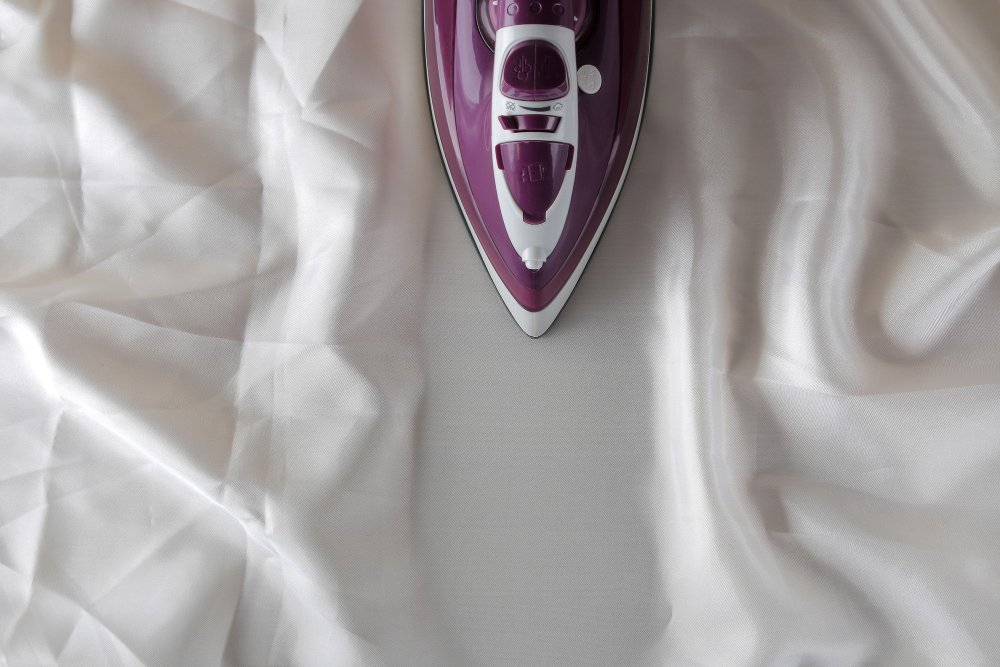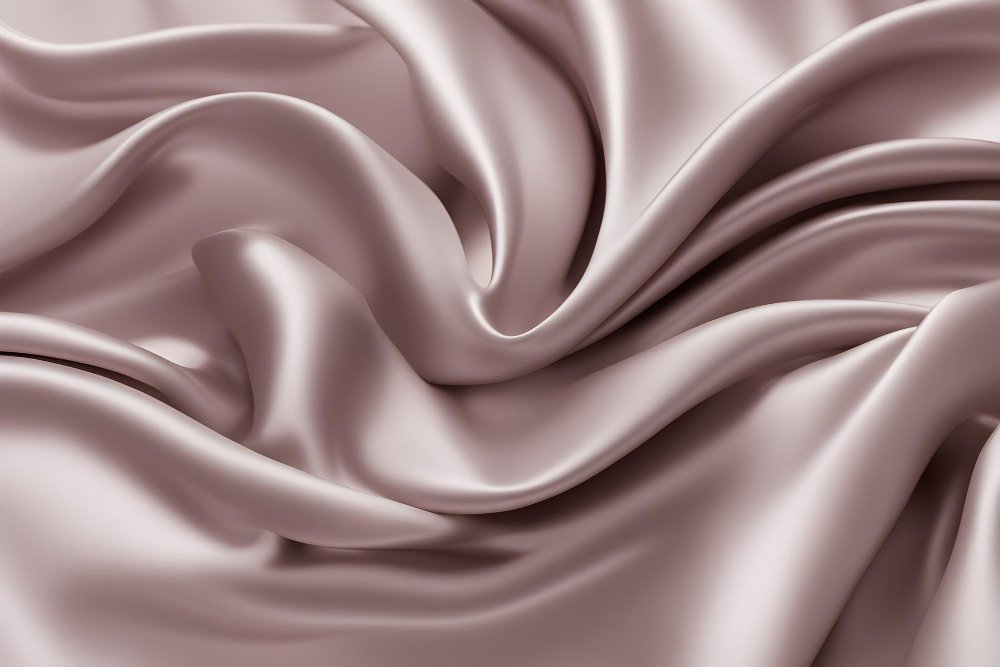Everything you need to know about Habotai silk, from its Japanese origins to modern applications, care instructions, and sustainability
Table of Contents
Picture this: a Chinese empress sits beneath mulberry trees in ancient times, sipping tea, when a silkworm cocoon falls into her cup. As the hot water dissolves the cocoon, she watches beautiful threads unfurl, shimmering in the sunlight. This legendary moment gave birth to silk, and centuries later, Japanese artisans perfected one of its most practical forms: Habotai silk.
Today, Habotai (also spelled Habutai) remains one of the most accessible and useful silk fabrics available. Whether you’re a fashion designer, eco-conscious consumer, or someone who simply loves beautiful textiles, understanding this material can transform how you approach both wardrobe and home projects.
What is Habotai Silk?
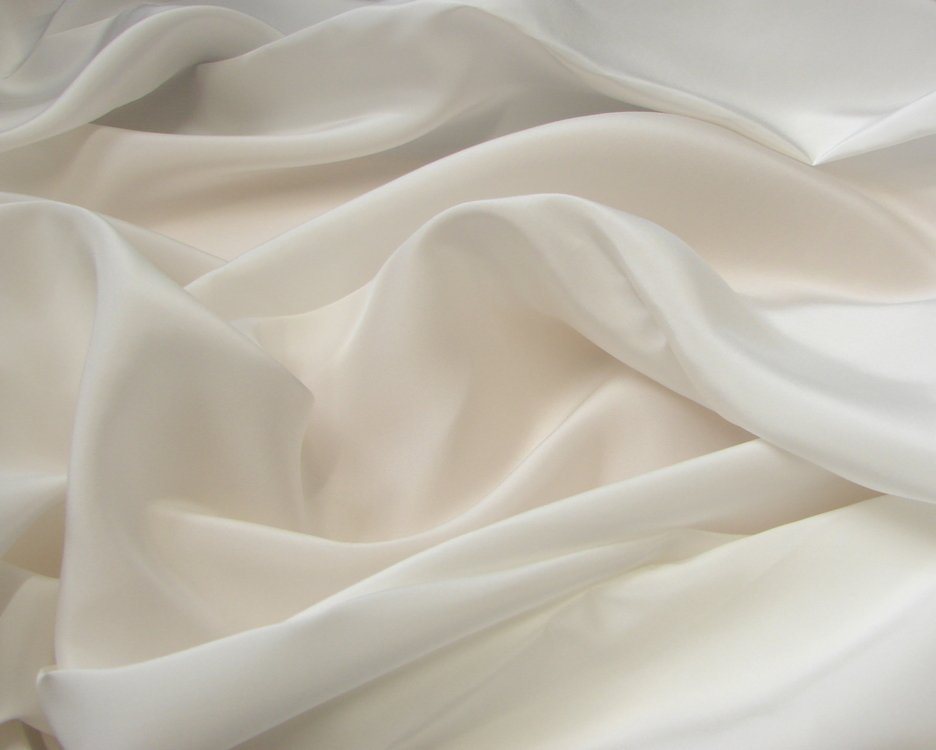
Close up view of white habotai silk with a fluid, airy drape
Habotai silk is a lightweight, plain-weave silk fabric made from 100% mulberry silk. The name comes from the Japanese word “habutae” (羽二重), which literally translates to “feather-two-layer,” perfectly capturing the fabric’s incredibly soft, light feel.
What makes Habotai different from other silks is its plain weave structure. Unlike more complex silk weaves, Habotai uses the simplest over-under pattern, creating a fabric that looks and feels the same on both sides. This gives it a subtle, understated sheen rather than the high shine you’ll find in satin or charmeuse.
Key Characteristics
- Texture: Smooth with a soft hand, slightly crisp when new
- Appearance: Gentle luster with no shiny/matte contrast between sides
- Weight: Available in 5mm to 20mm (momme), with 8mm most common
- Transparency: Light weights (5-8mm) are semi-sheer to sheer
- Drape: Fluid and elegant, especially in lighter weights
- Density: Surprisingly high thread count despite lightweight feel
What does silk Habotai feel like? Imagine touching a cloud with structure. Habotai feels softer than paper but more substantial than chiffon. When you run your fingers across it, you’ll notice a smooth, almost slippery surface that’s cooler than cotton. The fabric has a slight body to it, meaning it won’t collapse completely in your hand like very sheer fabrics do. Many people describe it as having a “whispery” quality, both in sound and touch.
The History and Cultural Heritage of Habotai Silk
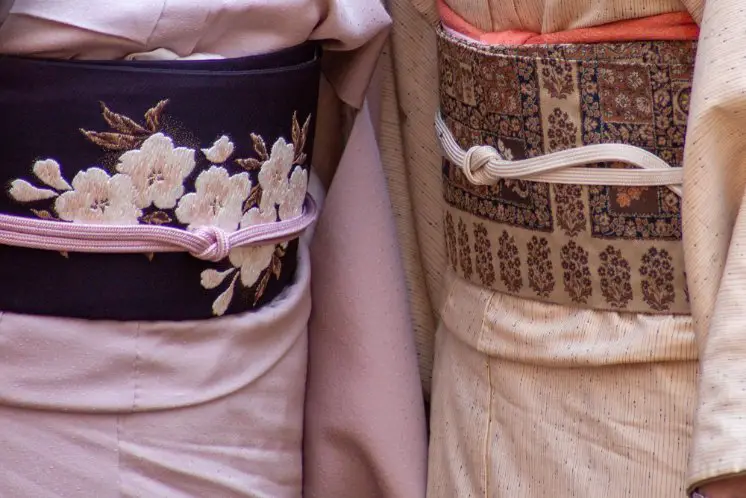
Traditional Japanese kimono showing decorative obi belts with detailed patterns
While silk production began in ancient China around 2640 BC, Habotai’s story really starts in Japan. The Japanese refined silk production into an art form, developing specialized weaving techniques that balanced beauty with practicality.
Origins and Traditional Use
Habotai silk was originally developed as a lining fabric for kimonos, Japan’s traditional garment. The lightweight, breathable nature made it perfect for summer kimonos and as an underlayer for heavier silk garments. The name “cooked silk” refers to the degumming process used in its production, where silk fibers are boiled to remove the natural gum (sericin).
In Fukui city, Japan, artisans completed the basic technology for weaving Habotai in 1887. This wasn’t just a technical achievement but marked a turning point in textile production. Fukui developed a unique method called “nureyoko” (濡れ横), which involves wetting the weft threads with water before weaving them with the warp threads. This technique created a tighter, more refined fabric.
Economic Impact
The economic boom during the Russo-Japanese War (1904-1905) and World War I dramatically increased demand for Habotai. By the early 1900s, Fukui’s production earned $1.7 million annually, accounting for up to 60% of Japan’s total Habotai exports. The fabric became so prized that it was used for judges’ robes and other formal government attire, symbols of dignity and refinement.
Modern Production
Today, most Habotai production has shifted to China, India, and Korea, where silk farming is done at larger scales and lower costs. However, Japanese-made Habotai still commands premium prices due to its superior quality and traditional production methods. Italian and French manufacturers also produce luxury versions of this fabric, often with special finishes or treatments.
Where does Habotai silk come from? While historically from Japan, today’s Habotai silk primarily comes from China (especially Zhejiang Province, including Hangzhou and Huzhou), followed by India, Korea, and Japan. High-end European producers in Italy and France also create premium versions using imported raw silk.
Understanding Momme Weight: Your Complete Buying Guide
When shopping for Habotai silk, you’ll encounter the term “momme” (abbreviated as “mm”). This traditional Japanese unit measures silk fabric weight and density. One momme equals 4.340 grams per square meter, but you don’t need to do math to understand what different weights mean for your projects.
Lightweight: 5-8mm
Best for: Scarves, delicate accessories, garment linings, eye masks, lightweight summer tops
Transparency: Semi-sheer to sheer
Typical price: $10-20 per yard
Note: 8mm is the most popular weight for scarves and silk painting projects
Medium Weight: 10-12mm
Best for: Blouses, dresses, children’s clothing, lightweight curtains, pillowcases
Transparency: Slightly translucent
Typical price: $20-30 per yard
Note: Good balance between drape and structure
Heavy Weight: 12-20mm
Best for: Jacket and suit linings, structured garments, petticoats, home decor
Transparency: Opaque
Typical price: $30-45 per yard
Note: More durable for everyday wear
Higher momme weights don’t automatically mean better quality. The right weight depends entirely on your intended use. For instance, a 5mm Habotai is perfect for a flowing scarf but would be too delicate for a dress that needs structure.
Habotai vs Other Silks: The Complete Comparison
Understanding how Habotai compares to other silk types helps you make smarter fabric choices. Here’s everything you need to know about the differences.
What is the difference between silk charmeuse and silk Habotai?

Habotai silk on the left compared with silk charmeuse on the right
This is probably the most common question about Habotai, and for good reason. These two fabrics serve different purposes despite both being silk.
| Feature | Habotai | Charmeuse |
|---|---|---|
| Weave Type | Plain weave | Satin weave |
| Sheen | Subtle, matte-like glow | High shine on one side |
| Both Sides | Identical front and back | Shiny front, dull back |
| Drape | Good, but more structured | Luxurious, fluid drape |
| Stretch | Almost none | Slight elasticity |
| Price Range | $10-45 per yard | $40-100+ per yard |
| Common Uses | Linings, scarves, summer wear | Evening gowns, luxury bedding |
| Care Difficulty | Moderate (machine washable) | High (often dry clean only) |
In simple terms: Habotai is the practical, everyday silk, while charmeuse is the glamorous, special-occasion silk. Charmeuse will always look more expensive and luxurious, but Habotai wins on versatility and affordability.
Habotai vs Mulberry Silk
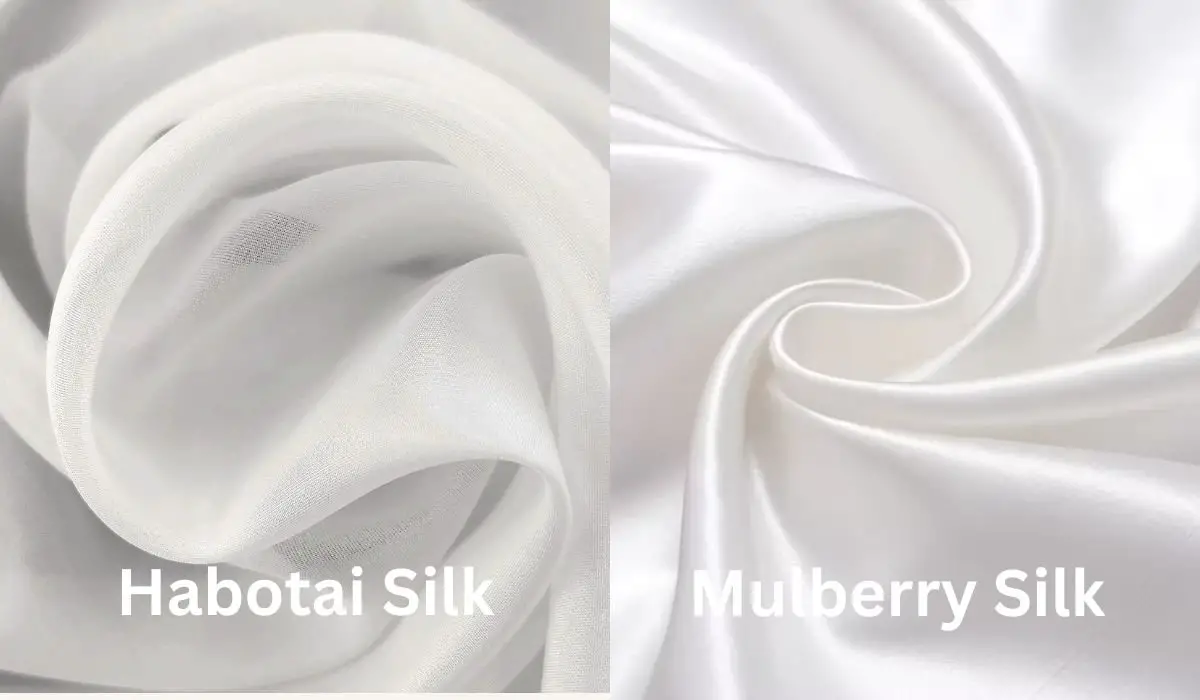
Habotai silk on the left beside luxurious mulberry silk on the right
Here’s where things get interesting. Habotai IS made from mulberry silk, so they’re not really competing fabrics. Think of it this way: mulberry silk is the ingredient (the type of silk fiber), while Habotai describes how that silk is woven (the recipe).
Mulberry silk can be woven into charmeuse, satin, crepe de chine, or Habotai. They’re all mulberry silk, just processed differently. When someone says “mulberry silk,” they’re usually referring to higher momme weight charmeuse or satin weaves used in bedding.
What is the difference between Habotai and crepe de Chine?

Habotai silk compared with crepe de Chine fabric
| Feature | Habotai | Crepe de Chine |
|---|---|---|
| Surface Texture | Smooth | Slightly pebbled/crinkled |
| Yarn Twist | Minimal twist | High twist yarns |
| Appearance | Flat, subtle sheen | Matte with pearl-like luster |
| Drape | Good, slightly crisp | Excellent, very fluid |
| Shrinkage | About 5% | Higher (yarns twist more when wet) |
| Wrinkle Resistance | Good | Excellent |
Crepe de Chine feels more substantial and has better wrinkle resistance, making it popular for travel clothing. Habotai is lighter and smoother, better suited for linings and accessories.
Other Silk Comparisons
Habotai vs Satin: Satin refers to a weaving technique that creates a glossy surface, while Habotai refers to a specific plain-weave silk fabric. Silk satin is heavier, shinier, and more formal than Habotai.

Habotai silk on the left and satin fabric on the right
Habotai vs Dupioni: Dupioni has a crisp, textured surface with slubs (bumps), while Habotai is smooth. Dupioni is used for structured garments and home decor, while Habotai flows more naturally.

Habotai silk on the left compared with textured Dupioni silk on the right
Habotai vs Chiffon: Both are lightweight, but chiffon is much sheerer and more delicate. Chiffon has a slightly rough texture due to its highly twisted yarns, while Habotai feels smoother.

Comparison of habotai silk on the left and chiffon fabric on the right
Which silk is the highest quality silk?
Quality isn’t about the type of silk, but rather the grade of the silk fibers and the craftsmanship. That said, here’s the general quality hierarchy:
- 6A Grade Mulberry Silk (19-25mm charmeuse): Highest quality, longest fibers, most expensive
- Grade A Mulberry Silk (16-19mm): Excellent quality, common in luxury bedding
- Grade B Mulberry Silk (12-16mm): Good quality, slightly shorter fibers
- Lower Grades: May mix different quality fibers or use shorter strands
Within Habotai specifically, Japanese-made fabric from Fukui represents the highest quality, followed by Italian and French production. Chinese Habotai varies widely in quality depending on the manufacturer.
Properties and Benefits: Why Choose Habotai?
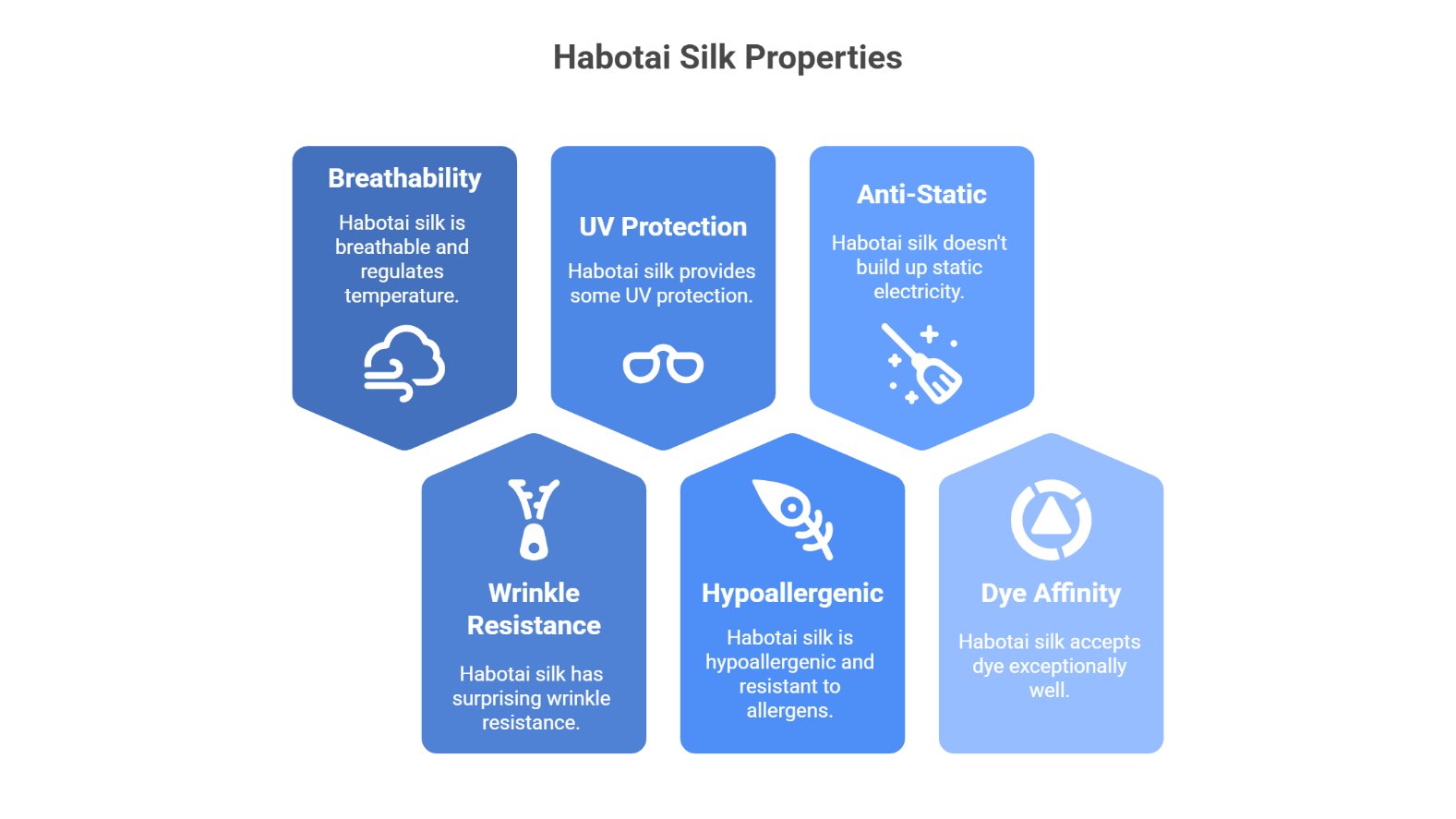
Key performance features of habotai silk
Habotai silk offers a unique combination of properties that make it surprisingly practical for everyday use, not just special occasions.
Breathability and Temperature Regulation
Is Habotai silk breathable? Yes, extremely! Silk is one of the most breathable natural fibers. Habotai’s tight plain weave actually enhances its moisture-wicking properties. When you sweat, the fabric pulls moisture away from your skin and allows it to evaporate quickly on the fabric’s surface. This keeps you feeling dry and fresh in warm, humid weather.
The fabric naturally adapts to your body temperature. In summer, it feels cool against your skin. In cooler weather, it provides gentle insulation without bulk. This makes Habotai perfect for layering or travel clothing that needs to work in different climates.
Wrinkle Resistance
Unlike charmeuse, which shows every wrinkle, Habotai has surprising wrinkle resistance. When small folds form, the fabric tends to smooth itself out naturally. This doesn’t mean it never wrinkles, but it recovers better than most other silks, making it more practical for everyday wear and travel.
UV Protection
Here’s something many people don’t know: silk naturally contains a protein called sericin that helps absorb ultraviolet rays. Combined with Habotai’s tight weave structure, this creates a fabric with built-in sun protection. While you shouldn’t rely on it as your only sunscreen, wearing a Habotai scarf or shirt does provide some physical barrier against harmful UV rays.
Hypoallergenic Properties
Silk is naturally hypoallergenic and resistant to dust mites, mold, and other allergens. This makes Habotai an excellent choice for people with sensitive skin or allergies. The smooth fibers don’t irritate skin the way some synthetic fabrics can.
Anti-Static Qualities
Unlike synthetic fabrics, silk doesn’t build up static electricity. This property, combined with its smooth surface, makes Habotai useful beyond clothing. It’s actually used as cleaning cloths for precision instruments and optical lenses because it won’t scratch delicate surfaces or attract dust particles.
Dye Affinity
Habotai accepts dye exceptionally well, making it a favorite for textile artists and silk painters. The fabric absorbs color evenly and holds it permanently when properly heat-set. This is why you’ll find Habotai in so many vibrant colors and hand-painted designs.
Sustainability and Ethical Considerations
If you’re an eco-conscious consumer, you need to understand both the positives and challenges of silk production. The truth is complex.
Environmental Impact
Silk production has both natural advantages and serious environmental costs:
The Good:
- 100% biodegradable natural fiber
- Renewable resource (silkworms reproduce naturally)
- Long-lasting, reducing need for frequent replacement
- Requires less water for washing than cotton
The Challenging:
- Producing 1kg of silk requires approximately 3,000 liters of water
- Growing the mulberry leaves needed demands 187kg of leaves per 1kg of silk
- Many silk facilities still use coal power, generating high greenhouse gas emissions
- Large amounts of manure and fertilizer needed for mulberry cultivation
The environmental impact varies dramatically based on production methods. Traditional small-scale sericulture (silk farming) in rural communities has a much lower environmental footprint than large industrial operations.
Ethical Concerns
This is where silk production becomes truly controversial. Conventional silk production involves boiling silkworm cocoons with the pupae still inside, killing them before they can emerge as moths. Approximately 6,600 silkworms die to produce just 1kg of silk.
Beyond animal welfare, there are human concerns. Reports have documented child labor in India’s silk industry, with hundreds of thousands of children working in conditions exposed to toxic chemicals used in cocoon processing.
Better Alternatives
If these issues concern you, look for:
Peace Silk (Ahimsa Silk): This method allows silkworms to complete their life cycle and emerge from cocoons naturally before harvesting the silk. While more expensive and producing lower silk quality (the emerging moth breaks the continuous fiber), it addresses the ethical concerns. However, be aware that domesticated silkworms can’t survive long outside their cocoons due to thousands of years of selective breeding.
Organic Silk: Produced using organic farming methods without synthetic pesticides, herbicides, or fertilizers. This reduces environmental impact, though silkworms are still killed in conventional timing. Look for GOTS (Global Organic Textile Standard) certification.
Oeko-Tex Certified Silk: This certification means the silk is free of toxic chemicals from raw materials to end product, making it safer for both workers and consumers.
Small-Scale Community Sericulture: Traditional silk production on a small scale by local communities. This provides financial stability for rural villages while using less energy-intensive methods. The practice preserves local traditions and customs passed down through generations.
Second-Hand Silk: The most sustainable option is buying vintage or used silk items. This bypasses new production entirely while reducing textile waste.
Making Better Choices
To minimize impact when buying Habotai silk:
- Buy from transparent brands that disclose their production methods
- Choose organic or Oeko-Tex certified options when available
- Invest in quality over quantity – a well-made Habotai piece can last decades
- Care for your silk properly to extend its life
- Consider vintage or second-hand silk first
- Support small-scale artisan producers when possible
For more information on sustainable textile choices, visit the Textile Exchange, a global nonprofit working to accelerate sustainable practices in the textile industry.
Complete Care Guide: How to Wash and Maintain Habotai Silk
Good news: Habotai is actually one of the easier silks to care for at home. Let’s break down everything you need to know.
Can you wash Habotai silk?
Yes, Habotai silk is washable! Unlike delicate silks like chiffon or heavily embellished pieces, most Habotai can be washed at home with proper technique. In fact, tests show that Habotai holds up remarkably well to gentle washing, softening slightly but remaining otherwise unchanged.
Is silk Habotai washable? The answer is the same: yes, with care. However, always check your garment’s care label first. Items with embellishments, linings in different colors, or special finishes may need professional cleaning.
Hand Washing Method (Recommended)
- Pre-wash preparation: Turn the item inside out. Check for any stains and treat them before washing (test cleaning solution on a hidden area first).
- Water temperature: Fill a basin with cool to lukewarm water (never hot). Hot water can damage silk fibers and cause shrinkage.
- Detergent: Use a pH-neutral detergent designed for silk or delicates. You can also use a small amount of gentle shampoo (silk is a protein fiber just like hair!). Dissolve the detergent completely in water before adding your silk.
- Washing: Submerge the fabric and gently swish it around. Don’t scrub, twist, or wring. Let it soak for 3-5 minutes maximum. Silk is weaker when wet, so handle gently.
- Rinsing: Rinse thoroughly in cool, clean water. Change the water and rinse again until no soap remains. You might notice slight color in the water (this is normal dye release, not fading). To help set the dye, add a small amount of salt to the final rinse water.
- Removing water: Never wring or twist! Instead, lay the item flat on a clean, dry towel. Roll the towel up with the silk inside to absorb excess moisture. Press gently.
- Drying: Hang on a padded (non-wooden) hanger or lay flat to dry. Keep away from direct sunlight, which can yellow silk. Don’t use radiators or direct heat sources.
Machine Washing (When Appropriate)
You can machine wash some Habotai items if you take precautions:
- Only machine wash solid-colored, unlined, unembellished pieces
- Turn inside out and place in a mesh lingerie bag
- Use the delicate or hand-wash cycle
- Set to cold water (30°C/86°F maximum)
- Use gentle detergent for delicates
- Set spin to lowest speed or skip spin cycle
- Remove immediately when cycle ends (never let it sit)
If your washing machine has a specific “silk” or “hand wash” cycle, use it.
Drying and Ironing
Drying: Air dry only. Never put silk in a dryer as the heat will damage fibers and cause shrinkage.
Ironing: Iron while the fabric is still slightly damp for best results. Use the lowest heat setting (100-150°C/200-300°F) labeled “silk” on your iron. Always iron on the wrong side or use a pressing cloth. Don’t leave the iron in one spot. Keep it moving.
Steaming trick: Hang your Habotai item in the bathroom while you take a hot shower. The steam will release most wrinkles naturally, often eliminating the need for ironing.
Storage
- Store rolled rather than folded when possible to prevent permanent creases
- Keep in a breathable cotton bag, not plastic
- Store away from direct sunlight
- Avoid wooden hangers or storage, which can stain silk
- Ensure items are completely dry before storing
Shrinkage Expectations
Habotai typically shrinks about 5% with first washing. Some sources report up to 10% shrinkage in length and 2% in width. To account for this, either pre-wash your fabric before sewing or buy slightly more than you need.
Stain Treatment
For stubborn stains:
- Treat immediately (old stains are much harder to remove)
- Blot, don’t rub
- Test any cleaning solution on a hidden area first
- For oil-based stains, sprinkle with cornstarch to absorb oil before washing
- For water-based stains, dab with cool water and gentle detergent
- When in doubt, take to a professional cleaner experienced with silk
For detailed guidance on caring for various silk types, including Habotai, check out our comprehensive silk care guide.
What is Silk Habotai Used For? Applications and Uses
Habotai’s unique combination of affordability, lightweight feel, and durability makes it useful for a surprising range of applications.
Fashion and Apparel
Garment Linings: This is Habotai’s primary traditional use. The smooth surface allows outer garments to slip on and off easily, while the breathability keeps you comfortable. It’s perfect for lining jackets, blazers, pants, skirts, and wedding dresses.
Summer Clothing: Lightweight Habotai makes beautiful summer blouses, shirts, tunics, and dresses. The fabric’s breathability and moisture-wicking properties make it ideal for warm weather.
Scarves: 8mm Habotai is the classic weight for scarves. It’s light enough to drape beautifully but substantial enough to hold color vibrantly. Hand-painted silk scarves are almost always made from Habotai.
Lingerie and Sleepwear: The smooth, cool feel against skin makes Habotai comfortable for intimate apparel. It won’t irritate sensitive skin or create static.
Children’s Clothing: The hypoallergenic properties and soft texture make lightweight Habotai suitable for children’s summer clothes.
Home and Decor
Curtains and Drapes: Heavier weights of Habotai create elegant, lightweight window treatments that filter light beautifully without blocking it completely.
Tablecloths: For special occasions, Habotai tablecloths add elegance without the weight of damask or brocade.
Lampshades: The way Habotai diffuses light makes it perfect for lampshade covers, creating soft, warm illumination.
Pillow Covers: Some people prefer Habotai pillowcases to charmeuse because the matte finish feels less slippery and more substantial.
Specialty Uses
Eye Masks: The light-blocking properties of Habotai, combined with its soft feel, make it ideal for sleep masks.
Travel Sleep Sacks: Luxury brands make silk sleep sacks from Habotai for travelers. They’re light to pack, breathable, and provide a clean barrier in questionable hotel beds.
Dance Veils: Surprisingly, Habotai is popular for belly dance veils. Despite its delicate appearance, it withstands remarkable abuse (waving, snapping, getting stepped on) much better than you’d expect.
Textile Art: Artists love Habotai for silk painting, dyeing, and printing. The smooth surface and excellent dye uptake make it perfect for creating wearable art.
Banners and Flags: The lightweight yet durable nature makes Habotai suitable for decorative banners that need to hang and move gracefully.
Professional Uses
In professional settings, Habotai serves some unique purposes:
- Lens cleaning cloths: The smooth, anti-static surface won’t scratch optical glass
- Precision instrument cleaning: Used for delicate equipment that can’t tolerate abrasive materials
- Costume construction: Theater and film costumers use Habotai for period garments and costume linings
Buying Guide: Quality, Price, and Where to Shop
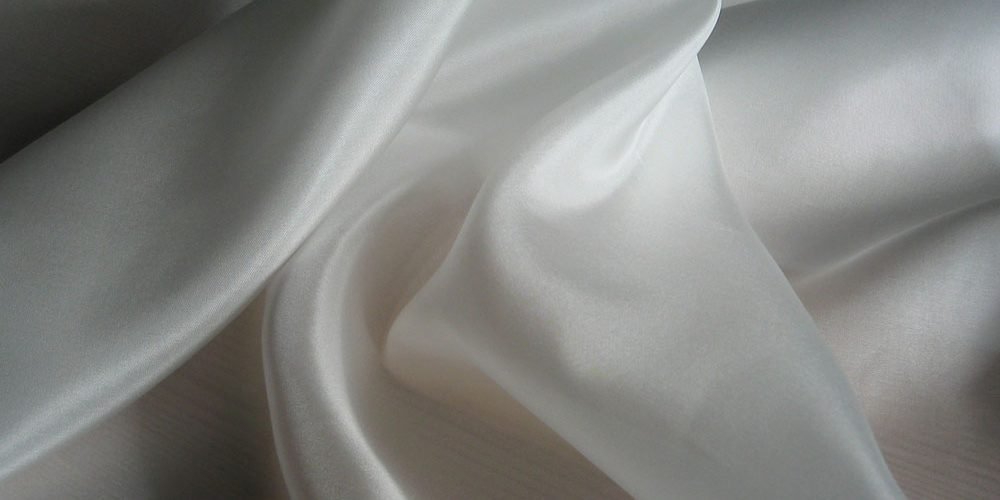
Soft white habotai silk showing its lightweight drape and smooth texture
Price Expectations
Habotai is one of the most affordable silk options:
- Basic quality (China-made): $10-20 per yard
- Mid-range quality: $20-35 per yard
- Premium (Japanese, Italian, French): $40-60+ per yard
Compare this to charmeuse ($40-100+ per yard) or dupioni ($35-80 per yard), and you can see why Habotai is popular for projects that need real silk on a budget.
Quality Indicators
How do you know if you’re getting good Habotai?
Check the weave: Hold the fabric up to light. Higher quality Habotai has an even, tight weave with no irregular gaps or thick/thin areas. The threads should be uniform.
Feel test: Quality Habotai feels smooth and cool to the touch. It should have a slight weight to it (not paper-thin unless it’s intentionally 5mm). Lower quality silk feels rougher or has an almost synthetic texture.
Sheen test: Good Habotai has a subtle, natural luster. Excessive shine might indicate a treated or lower-quality fabric trying to look more expensive.
Color test: Tap a damp white cloth on the fabric. High-quality dyed silk might release a tiny bit of color, but it shouldn’t bleed excessively. The fabric itself shouldn’t show fading from this test.
Burn test: This is destructive, but if you have a sample: Real silk smells like burning hair (both are protein), curls away from flame, and leaves a crushable ash. Synthetic fabrics smell like burning plastic, melt, and leave a hard bead.
Where to Buy
Online Fabric Retailers:
- Dharma Trading (great for dyeable Habotai)
- Thai Silks (wide selection, good prices)
- Silk Baron (higher-end options)
- FabricMart (varies, check frequently)
Local Options: Check specialty fabric stores in your area. Being able to feel the fabric before buying is worth the potentially higher price, especially for your first Habotai purchase.
International Sources: If ordering from overseas suppliers, be aware of import duties and longer shipping times. AliExpress and similar platforms offer very cheap Habotai, but quality varies greatly (read reviews carefully).
What to Ask Before Buying
- What’s the momme weight?
- What’s the width? (Common widths: 36″, 45″, 54″)
- Is it pre-washed or does it require washing before use?
- What’s the country of origin?
- Is it dyeable (if you plan to dye it)?
- Can I get a sample before ordering yardage?
Many quality retailers offer sample swatches for a few dollars, which is well worth it before committing to several yards.
Working with Habotai: Tips for Sewers and Designers
If you’re planning to sew with Habotai, here’s what you need to know.
Pre-Sewing Preparation
Pre-washing: Always pre-wash your Habotai if you’re making a garment that will be washed later. This accounts for the 5-10% shrinkage and tests colorfastness. Wash using the hand-washing method described earlier, then press while still slightly damp.
Layout and cutting: Let Habotai rest flat for a few hours before cutting. The fabric can relax and shift after being on the bolt. Use sharp scissors or a rotary cutter (dull blades will snag silk fibers).
Sewing Techniques
Needles: Use a fresh, sharp microtex or silk needle (size 60/8 to 70/10). Dull or large needles will leave visible holes in the fabric.
Thread: Use silk thread for the best results, or a high-quality mercerized cotton thread in matching color. Polyester thread can be too strong and may pucker silk.
Pins: Use fine silk pins or extra-fine glass head pins. Regular pins can leave holes. Better yet, pin within the seam allowance or use clips instead.
Basting: Because Habotai is slippery, baste seams before sewing to prevent shifting. Hand basting with silk thread works best, but you can also use fabric clips or tape designed for slippery fabrics.
Stitch length: Use a slightly smaller stitch length (2.0-2.5mm) for better seam integrity. Test on scraps first.
Seam finishes: French seams work beautifully with Habotai and hide raw edges for a professional finish. For garment linings, you can use simple flat-felled seams.
Gathering and Pleating
Habotai gathers and ruches easily, making it perfect for details like:
- Gathered necklines
- Ruched sleeves
- Shirred waistlines
However, due to its thinness, pleats won’t hold well unless the fabric is backed with something sturdier. For structured pleats, interface or line your Habotai.
Underlining and Lining
For lightweight Habotai (8mm and under), consider using an underlining:
- Cotton voile for breathable summer garments
- Cotton broadcloth for more structure
- Batiste for a soft, lightweight option
Pattern Considerations
Habotai works best with:
- Flowing, draped designs
- Bias-cut garments (though be careful, silk can stretch on the bias)
- Simple silhouettes without too many seams
- Loose-fitting garments
Avoid using Habotai for:
- Very fitted garments (it doesn’t have give)
- Heavy-duty items that need structure
- Anything requiring crisp pleats (unless lined)
Dyeing Habotai
Habotai is one of the best fabrics for dyeing and silk painting. It accepts acid dyes, fiber reactive dyes, and natural dyes beautifully. Always buy “natural white” or “dyeable white” Habotai if you plan to color it yourself. Pre-dyed Habotai can be over-dyed for deeper colors, but test first.
Frequently Asked Questions
Conclusion
After exploring everything from the ancient mulberry trees of China to modern applications, one thing becomes clear: Habotai silk is a remarkable fabric that deserves more attention than it typically receives.
Key Takeaways
Quick Summary: When to Choose Habotai
Choose Habotai if you want:
- Affordable luxury (most budget-friendly silk option)
- Breathable, lightweight fabric for warm weather
- Easy-care silk you can wash at home
- Versatile material for multiple projects (scarves, linings, summer clothing)
- A base for dyeing or silk painting
- Natural, hypoallergenic fabric for sensitive skin
Choose something else if you need:
- High-glamour shine (go with charmeuse or satin)
- Heavy drape for evening gowns (choose charmeuse)
- Crisp structure (try dupioni or taffeta)
- Very sheer overlay (use chiffon or organza)
- Maximum wrinkle resistance (look at crepe de chine)
The Bottom Line on Quality and Value
Habotai represents one of the best value propositions in the silk world. While it won’t give you the red-carpet glamor of charmeuse or the crisp elegance of dupioni, it delivers everyday luxury in a practical package. For the price of a mid-range synthetic, you get real silk with all its natural benefits: breathability, temperature regulation, hypoallergenic properties, and that unmistakable feel against skin.
The fabric’s versatility means one type of material serves multiple purposes. A few yards can become scarves, garment linings, summer blouses, home decor, and textile art. This makes it excellent for both hobbyists experimenting with silk for the first time and professionals who need reliable, affordable silk in quantity.
Sustainability Considerations
The environmental and ethical picture is mixed. Traditional silk production has serious concerns, from water use to animal welfare to labor practices. However, improvements are happening. More producers offer organic, peace, or ethically sourced silk. Small-scale community sericulture provides sustainable livelihoods while preserving cultural traditions.
Your choices matter. By seeking out transparently sourced Habotai, caring for pieces properly to extend their life, and buying quality over quantity, you can enjoy this beautiful material more responsibly. Second-hand silk remains the most sustainable option. Vintage Habotai scarves and garments offer the same luxury without new production impact.
Cultural Connection
When you work with Habotai, you’re touching a thread (literally) that connects to thousands of years of human ingenuity. From ancient Chinese silk roads to Japanese kimono traditions to modern sustainable fashion, this fabric carries history in every fiber. The fact that traditional methods like Fukui’s wet-weft weaving still produce superior results reminds us that older doesn’t always mean outdated.
Practical Recommendations
If you’re new to Habotai:
- Start small: Order samples from different suppliers to compare quality before buying yardage. A $5 sample can save you from wasting money on unsuitable fabric.
- Begin with 8mm: This middle weight is the most versatile. It’s substantial enough to work with easily but still shows off silk’s beautiful drape.
- Try a simple project first: Make a scarf or simple pillowcase before attempting a complex garment. This lets you get comfortable with the fabric’s behavior.
- Don’t fear washing: Unlike delicate silks, Habotai is forgiving. Follow the care instructions, and you’ll find it holds up better than expected.
- Invest in proper tools: A good silk needle and pins make a huge difference. These small investments prevent frustration and fabric damage.
For experienced sewers and designers, Habotai offers opportunities beyond basic projects. Consider experimenting with natural dyeing, shibori techniques, or block printing. The fabric’s excellent dye uptake and affordable price make it perfect for learning textile art techniques without risking expensive materials.
Looking Forward
The future of Habotai silk depends on balancing tradition with innovation. As consumers demand more sustainable and ethical textiles, the silk industry is responding. New methods like lab-grown silk proteins and peace silk production are emerging. Small-scale artisan producers are finding new markets through online platforms.
Technology is also improving production efficiency while reducing environmental impact. Better water recycling, natural dye processes, and renewable energy in silk facilities are becoming more common. These changes mean choosing silk may become an increasingly sustainable option in coming years.
Final Thoughts
Habotai silk proves that luxury doesn’t have to be expensive or complicated. This “humble” silk, originally designed as a utilitarian lining fabric, has become beloved worldwide for its versatility, beauty, and accessibility. Whether you’re lining a jacket, painting a scarf, making summer pajamas, or creating textile art, Habotai offers the genuine silk experience without the prohibitive cost.
The fabric’s story (from ancient sericulture to modern applications) reminds us that the best materials often combine time-tested qualities with practical usefulness. As you work with or wear Habotai, you’re participating in a craft tradition that spans cultures and centuries, adapted for contemporary life but still honoring its origins.
In a fashion world increasingly focused on fast fashion versus slow fashion, Habotai silk represents a middle path: affordable enough to be accessible, quality enough to last for years, and versatile enough to serve many purposes. That combination makes it truly special.
Ready to experience Habotai for yourself? Start with a sample, feel the difference real silk makes, and discover why this “feather-two-layer” fabric has remained beloved for over a century. Whether you’re creating something beautiful or simply enjoying the luxury of natural fibers, Habotai silk is ready to become part of your textile journey.
For more detailed information about silk production and standards, visit the International Sericultural Commission and learn about what to know about silk fabric for a broader perspective on silk types and uses.
To explore more natural fabrics and their properties, see our guides on cotton fabric and linen fabric.

